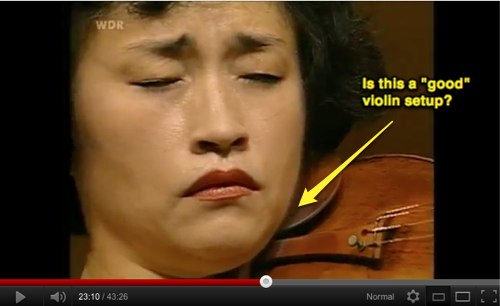Parents: Are your kids just getting started on violin? I’m not going to pull any punches. In my studio, violin lessons can get pretty intense, fast. There’s a lot to remember, and a lot that can go wrong. All of this means that the average 5 to 8 year (and you, as his home teacher) will need draw upon an unusual amount of focus, a reasonably robust physical makeup and some real fine muscle control.
Even something as simple as the slope of a shoulder and the relative position of a collarbone can make holding and playing nearly impossible for some kids until the moment is right. But not all is lost!
Six “Must Have” Skills for your Future Invincible Violinist
So, here’s my short list of necessary activities that will support the first song your child will likely need to learn in a Suzuki (and/or) traditional violin studio:
- The Twinkle Rhythm Vocabulary. Be able to clap these the six basic twinkle rhythms accurately, crisply and at consistent tempo.
- Clap and March Be able to march in time with the songs from the Suzuki Volume 1 CD, and at the same time clap at a matching or (if appropriate) double speed.
- Match Pitches Be able to sing and match a pitch in the range of middle C to G, after hear thing pitch sung or played on a keyboard.
- Follow a Melodic Contour Be able to sing along with a familiar melody, and follow the up and down contour of that melody, if not the exact pitches.
- Object Focus Be able to visually focus on a single object for increasing intervals, without turning away or being distracted.
- Tone Up Be able to hold an empty violin case in front of the body with arms fully extended. Be able to march in tempo with empty case held above crown of the head.
- Tap and Count Be able to demonstrate fine muscle control and basic counting skills using a simple song.
The honest truth: if your child has significant problems with any of these items her violin journey will likely be short. Don’t let this happen to your family!
Here’s the Proven Invincible Practice Strategy
This list is fairly basic, but at least one point deserves your consideration:
Set up your kids to be successful from the start. Break down these activities into their simplest components so that every repetition, every practice session, is in some way successful. This is at the heart of the Invincible Violin system.
Add complexity as appropriate to the development of your child. Instill the belief that can meet challenges and continually improve. At all costs, avoid dull, mindless repetition of any activity. Constantly provide your attention and support, provide praise when appropriate, and never offer it when it isn’t merited.
Here’s a website loaded with ideas and tools that can help with early motor skill development.
Grab The Unbelievable Power of Getting the Basics Right
This stuff is way, way underrated. The connections to playing with a beautiful tone and great technique aren’t obvious to the average person. But a lifetime of playing and a decade of teaching has shown me otherwise.
Parents and kids alike are always super excited to get started on the instrument and learning songs. That’s great, but motivation dies quickly without having these six skills mastered. And that’s sad, and all too common.
Whether it’s baseball, math or violin the fundamentals do count. As parents, it’s our job to give our kids this solid starting point. It’s the foundation of becoming Invincible.
Why You Should Get Started Now
Don’t waste time! If the moment is right to start actual playing, there’s plenty you can do to make that moment shine when it finally arrives.
Have your own “too young” story or question to share? Please leave a comment below!


